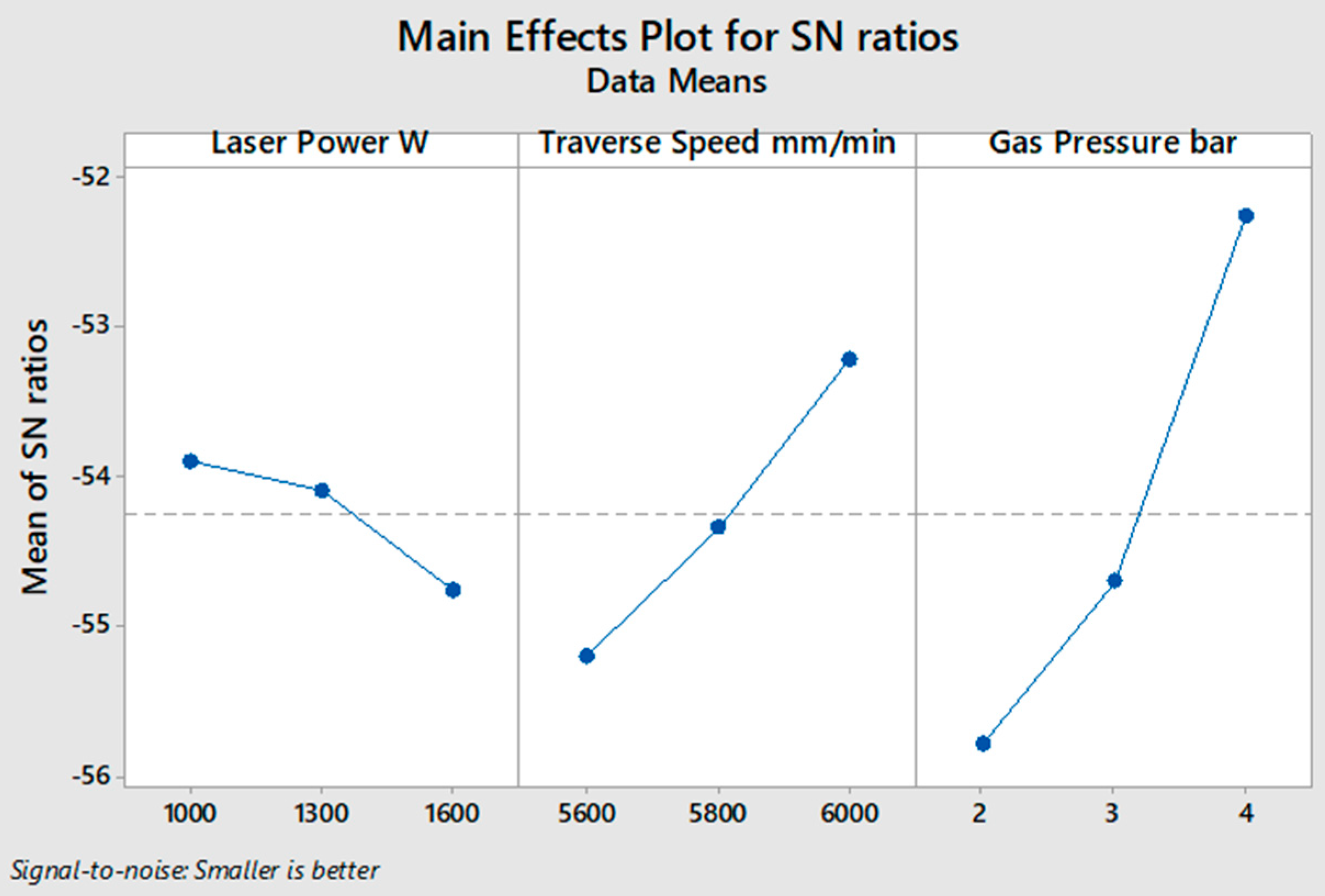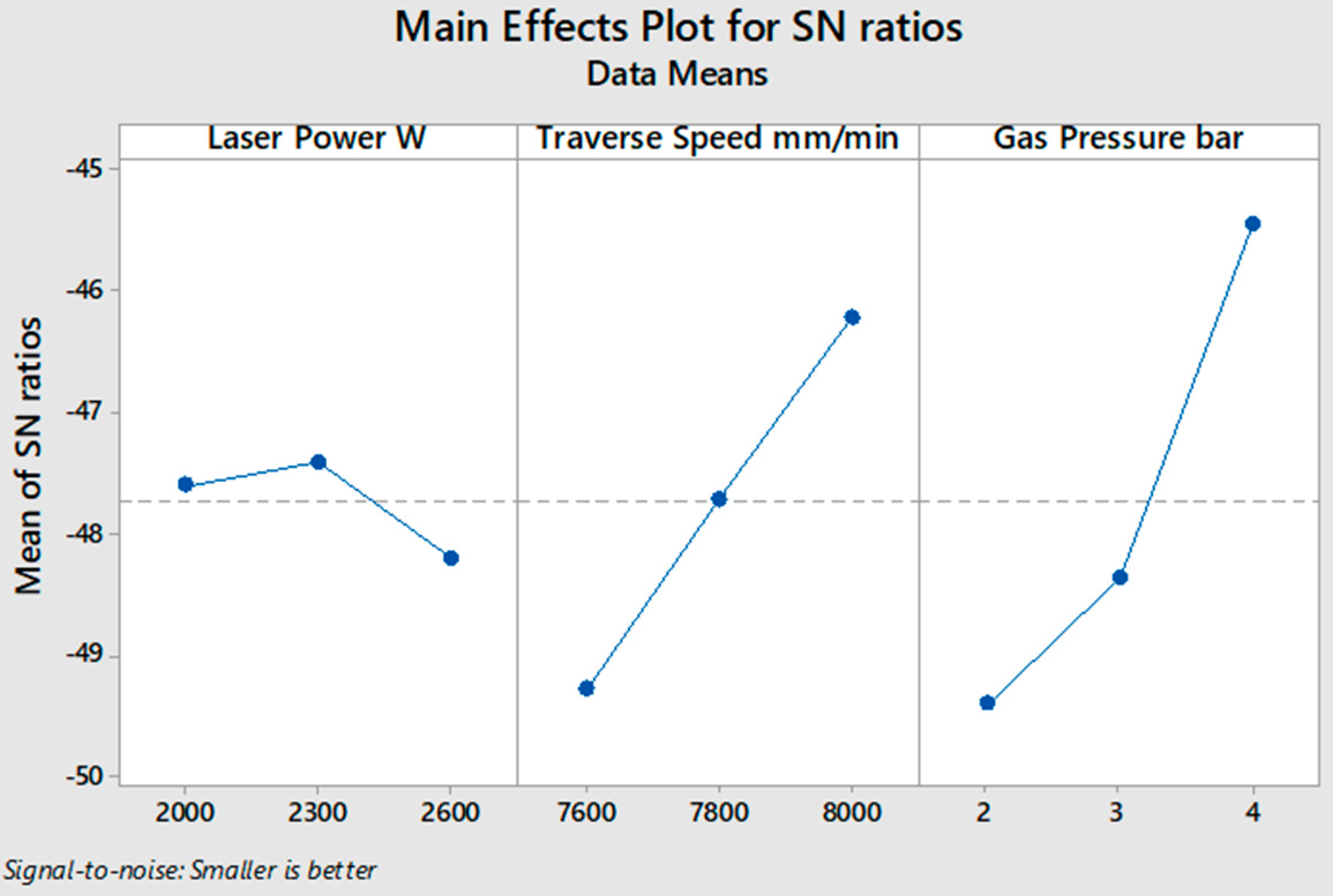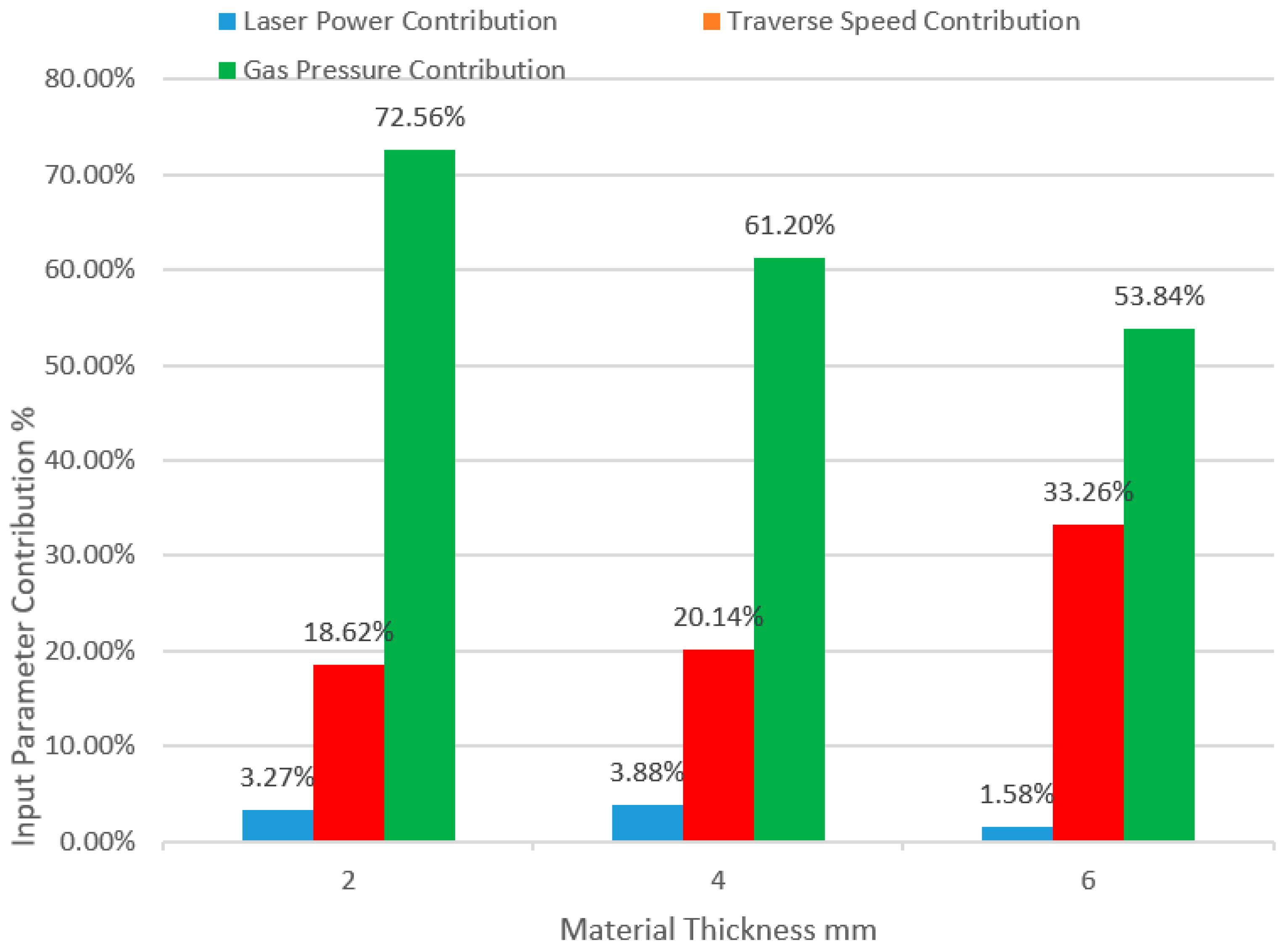Experimental Analysis of Heat-Affected Zone (HAZ) in Laser Cutting of Sugar Palm Fiber Reinforced Unsaturated Polyester Composites
Abstract
:1. Introduction
2. Materials and Methods
2.1. Composite Forming
2.2. Experimental Setup
2.3. Cutting Parameter Selection
2.4. HAZ Measurement
2.5. Optimization Methods
3. Results and Discussion
4. Conclusions
- The CO2 laser is capable of cutting SPF-UPE composites. Optimum input cutting parameters can yield improved quality of the cut material by using LBM technology.
- Assist gas pressure has the greatest influence on the HAZ, followed by traverse speed and laser power, respectively, for all material thicknesses, noting that the contribution of gas pressure to the influence on the HAZ decreases with the increase in material thickness, while the contribution of traverse speed increases with the increase in material thickness. Moreover, it was observed that laser power minimally contributes to the influence on the HAZ, which did not show a clear relationship with the change in material thickness.
- The optimum responses of the HAZ were recorded by applying higher levels of traverse speed and gas pressure in all cases of material thickness. However, the optimum values of the HAZ were generally recorded at the lower levels of laser power in all cases of thicknesses, except for 6 mm material thickness, where the optimum HAZ was recorded at the medium level of laser power, but the value of the HAZ in this case did not differ much from that which was recorded at the minimum level of laser power.
- Based on DOE Taguchi and ANOVA analysis methods, the optimum values of input parameters and the contributions in the case of 2 mm material thickness were 200 W laser power with a contribution of 3.27% and 250 mm/min traverse speed with a contribution of 18.62%, while the optimum gas pressure was 4 bar with a contribution of 72.56%. In the case of 4 mm material thickness, the optimum laser power was 1000 W with a contribution of 3.88%, and 6000 mm/min traverse speed with a contribution of 20.14%, while the optimum gas pressure was also 4 bar with 61.20%. In the experiment of 6 mm specimen thickness, 2300 W laser power gave the lowest desired response of the HAZ with a minimal contribution of 1.58%, while 8000 mm/min was the optimum traverse speed with a contribution of 33.26%, and the optimum value of gas pressure was also 4 bar with a contribution of 53.84%.
Author Contributions
Funding
Institutional Review Board Statement
Informed Consent Statement
Data Availability Statement
Acknowledgments
Conflicts of Interest
References
- Alaaeddin, M.H.; Sapuan, S.M.; Zuhri, M.Y.M.; Zainudin, E.S.; Al-Oqla, F.M. Physical and mechanical properties of polyvinylidene fluoride—Short sugar palm fiber nanocomposites. J. Clean. Prod. 2019, 235, 473–482. [Google Scholar] [CrossRef]
- Ammar, I.M.; Huzaifah, M.R.M.; Sapuan, S.M.; Leman, Z.; Ishak, M.R. Mechanical properties of environment-friendly sugar palm fibre reinforced vinyl ester composites at different fibre arrangements. EnvironmentAsia 2019, 12, 25–35. [Google Scholar]
- Neves Monteiro, S.; Salgado de Assis, F.; Ferreira, C.L.; Tonini Simonassi, N.; Pondé Weber, R.; Souza Oliveira, M.; Colorado, H.A.; Camposo Pereira, A. Fique fabric: A promising reinforcement for polymer composites. Polymers 2018, 10, 246. [Google Scholar] [CrossRef] [PubMed] [Green Version]
- Fujiyama, R.T.; Clay, A. Effect of Chemical Treatment and Length of Raffia Fiber (Raphia vinifera) on Mechanical Stiffening of Polyester Composites. Polymers 2020, 12, 2899. [Google Scholar]
- Masoud, F.; Sapuan, S.M.; Ariffin, M.K.A.M.; Nukman, Y.; Bayraktar, E. Cutting processes of natural fiber-reinforced polymer composites. Polymers 2020, 12, 1332. [Google Scholar] [CrossRef]
- Ilyas, R.A.; Sapuan, S.M.; Ishak, M.R.; Zainudin, E.S. Development and characterization of sugar palm nanocrystalline cellulose reinforced sugar palm starch bionanocomposites. Carbohydr. Polym. 2018, 202, 186–202. [Google Scholar] [CrossRef]
- Ishak, M.R.; Sapuan, S.M.; Leman, Z.; Rahman, M.Z.A.; Anwar, U.M.K.; Siregar, J.P. Sugar palm (Arenga pinnata): Its fibres, polymers and composites. Carbohydr. Polym. 2013, 91, 699–710. [Google Scholar] [CrossRef]
- Çelik, Y.H.; Kilickap, E.; Kilickap, A.İ. An experimental study on milling of natural fiber (jute)- reinforced polymer composites. J. Compos. Mater. 2019, 53, 3127–3137. [Google Scholar] [CrossRef]
- Lotfi, A.; Li, H.; Dao, D.V.; Prusty, G. Natural fiber–reinforced composites: A review on material, manufacturing, and machinability. J. Thermoplast. Compos. Mater. 2019. [Google Scholar] [CrossRef]
- Rajmohan, T.; Vinayagamoorthy, R.; Mohan, K. Review on effect machining parameters on performance of natural fibre–reinforced composites (NFRCs). J. Thermoplast. Compos. Mater. 2019, 32, 1282–1302. [Google Scholar] [CrossRef]
- Vinayagamoorthy, R.; Rajmohan, T. Machining and its challenges on bio-fibre reinforced plastics: A critical review. J. Reinf. Plast. Compos. 2018, 37, 1037–1050. [Google Scholar] [CrossRef]
- Nassar, M.M.; Arunachalam, R.; Alzebdeh, K.I. Machinability of natural fiber reinforced composites: A review. Int. J. Adv. Manuf. Technol. 2017, 88, 2985–3004. [Google Scholar] [CrossRef]
- Jani, S.P.; Kumar, A.S.; Khan, M.A.; Kumar, M.U. Machinablity of Hybrid Natural Fiber Composite with and without Filler as Reinforcement. Mater. Manuf. Process. 2016, 31, 1393–1399. [Google Scholar] [CrossRef]
- Maleki, H.R.; Hamedi, M.; Kubouchi, M.; Arao, Y. Experimental study on drilling of jute fiber reinforced polymer composites. J. Compos. Mater. 2019, 53, 283–295. [Google Scholar] [CrossRef]
- Sobri, S.A.; Heinemann, R.; Whitehead, D. Development of laser drilling strategy for thick carbon fibre reinforced polymer composites (Cfrp). Polymers 2020, 12, 1–21. [Google Scholar]
- Eltawahni, H.A.; Olabi, A.G.; Benyounis, K.Y. Investigating the CO2 laser cutting parameters of MDF wood composite material. Opt. Laser Technol. 2011, 43, 648–659. [Google Scholar] [CrossRef] [Green Version]
- El-Hofy, M.H.; El-Hofy, H. Laser beam machining of carbon fiber reinforced composites: A review. Int. J. Adv. Manuf. Technol. 2019, 101, 2965–2975. [Google Scholar] [CrossRef]
- Sharma, A.; Yadava, V. Experimental analysis of Nd-YAG laser cutting of sheet materials—A review. Opt. Laser Technol. 2018, 98, 264–280. [Google Scholar] [CrossRef]
- Hirsch, P.; Bastick, S.; Jaeschke, P.; van den Aker, R.; Geyer, A.; Zscheyge, M.; Michel, P. Effect of thermal properties on laser cutting of continuous glass and carbon fiber-reinforced polyamide 6 composites. Mach. Sci. Technol. 2019, 23, 1–18. [Google Scholar] [CrossRef]
- Abidou, D.; Yusoff, N.; Nazri, N.; Awang, M.A.O.; Hassan, M.A.; Sarhan, A.A. Numerical simulation of metal removal in laser drilling using radial point interpolation method. Eng. Anal. Bound. Elem. 2017, 77, 89–96. [Google Scholar] [CrossRef]
- Tamrin, K.F.; Nukman, Y.; Choudhury, I.A.; Shirley, S. Multiple-objective optimization in precision laser cutting of different thermoplastics. Opt. Lasers Eng. 2015, 67, 57–65. [Google Scholar] [CrossRef]
- Tamrin, K.F.; Moghadasi, K.; Sheikh, N.A. Experimental and numerical investigation on multi-pass laser cutting of natural fibre composite. Int. J. Adv. Manuf. Technol. 2020, 107, 1483–1504. [Google Scholar] [CrossRef]
- Tewari, R.; Singh, M.K.; Zafar, S.; Powar, S. Parametric optimization of laser drilling of microwave-processed kenaf/HDPE composite. Polym. Polym. Compos. 2020. [Google Scholar] [CrossRef]
- Bachtiar, D.; Sapuan, S.M.; Hamdan, M.M. The effect of alkaline treatment on tensile properties of sugar palm fibre reinforced epoxy composites. Mater. Des. 2008, 29, 1285–1290. [Google Scholar] [CrossRef]
- Norizan, M.N.; Abdan, K.; Salit, M.S.; Mohamed, R. Physical, mechanical and thermal properties of sugar palm yarn fibre loading on reinforced unsaturated polyester composites. J. Phys. Sci. 2017, 28, 115–136. [Google Scholar] [CrossRef] [Green Version]
- Atiqah, A.; Jawaid, M.; Sapuan, S.M.; Ishak, M.R. Physical properties of silane-treated sugar palm fiber reinforced thermoplastic polyurethane composites. IOP Conf. Ser. Mater. Sci. Eng. 2018, 368, 012047. [Google Scholar] [CrossRef]
- Rashid, B.; Leman, Z.; Jawaid, M.; Ghazali, M.J.; Ishak, M.R. The mechanical performance of sugar palm fibres (ijuk) reinforced phenolic composites. Int. J. Precis. Eng. Manuf. 2016, 17, 1001–1008. [Google Scholar] [CrossRef]
- Nugroho, G.; Winarbawa, H. Investigation of Agel Leaf Fiber/Unsaturated Polyester Composite Cutting Parameters Using CO2 Laser. In Proceedings of the 4th International Conference on Science and Technology (ICST), Daerah Istimewa Yogyakarta, Indonesia, 7–8 August 2018; pp. 1–5. [Google Scholar]
- Li, M.; Li, S.; Yang, X.; Zhang, Y.; Liang, Z. Effect of lay-up configuration and processing parameters on surface quality during fiber laser cutting of CFRP laminates. Int. J. Adv. Manuf. Technol. 2019, 100, 623–635. [Google Scholar] [CrossRef]
- Mathew, J.; Goswami, G.L.; Ramakrishnan, N.; Naik, N.K. Parametric studies on pulsed Nd:YAG laser cutting of carbon fibre reinforced plastic composites. J. Mater. Process. Technol. 1999, 89–90, 198–203. [Google Scholar] [CrossRef]
- Herzog, D.; Schmidt-Lehr, M.; Oberlander, M.; Canisius, M.; Radek, M.; Emmelmann, C. Laser cutting of carbon fibre reinforced plastics of high thickness. Mater. Des. 2016, 92, 742–749. [Google Scholar] [CrossRef]
- Petković, D.; Nikolić, V.; Milovančević, M.; Lazov, L. Estimation of the most influential factors on the laser cutting process heat affected zone (HAZ) by adaptive neuro-fuzzy technique. Infrared Phys. Technol. 2016, 77, 12–15. [Google Scholar] [CrossRef]







| Parameters | Level 1 | Level 2 | Level 3 |
|---|---|---|---|
| Laser Power (W) | 200 | 300 | 400 |
| Traverse Speed (mm/min) | 150 | 200 | 250 |
| Gas Pressure (bar) | 2 | 3 | 4 |
| Parameters | Level 1 | Level 2 | Level 3 |
|---|---|---|---|
| Laser Power (W) | 1000 | 1300 | 1600 |
| Traverse Speed (mm/min) | 5600 | 5800 | 6000 |
| Gas Pressure (bar) | 2 | 3 | 4 |
| Parameters | Level 1 | Level 2 | Level 3 |
|---|---|---|---|
| Laser Power (W) | 2000 | 2300 | 2600 |
| Traverse Speed (mm/min) | 7600 | 7800 | 8000 |
| Gas Pressure (bar) | 2 | 3 | 4 |
| Ex No: | Laser Power W | Traverse Speed mm/min | Gas Pressure bar | HAZ µm | S/N |
|---|---|---|---|---|---|
| 1 | 200 | 150 | 2 | 516 | −54.2530 |
| 2 | 200 | 200 | 3 | 304 | −49.6575 |
| 3 | 200 | 250 | 4 | 162 | −44.1903 |
| 4 | 300 | 150 | 3 | 438 | −52.8295 |
| 5 | 300 | 200 | 4 | 244 | −47.7478 |
| 6 | 300 | 250 | 2 | 390 | −51.8213 |
| 7 | 400 | 150 | 4 | 278 | −48.8809 |
| 8 | 400 | 200 | 2 | 594 | −55.4757 |
| 9 | 400 | 250 | 3 | 284 | −49.0664 |
| Level | Laser Power W | Traverse Speed mm/min | Gas Pressure bar |
|---|---|---|---|
| 1 | −49.37 | −51.99 | −53.85 |
| 2 | −50.80 | −50.96 | −50.52 |
| 3 | −51.14 | −48.36 | −46.94 |
| Delta | 1.77 | 3.63 | 6.91 |
| Rank | 3 | 2 | 1 |
| Source | DF | Seq SS | Contribution | Adj SS | Adj MS | F-Value | p-Value |
|---|---|---|---|---|---|---|---|
| Laser Power W | 2 | 5048 | 3.27% | 5048 | 2524 | 0.59 | 0.629 |
| Traverse Speed mm/min | 2 | 28,728 | 18.62% | 28,728 | 14,364 | 3.36 | 0.229 |
| Gas Pressure bar | 2 | 111,944 | 72.56% | 111,944 | 55,972 | 13.09 | 0.071 |
| Error | 2 | 8552 | 5.54% | 8552 | 4276 | ||
| Total | 8 | 154,272 | 100.00% |
| Ex no: | Laser Power W | Traverse Speed mm/min | Gas Pressure bar | HAZ µm | S/N |
|---|---|---|---|---|---|
| 1 | 1000 | 5600 | 2 | 652 | −56.2850 |
| 2 | 1000 | 5800 | 3 | 490 | −53.8039 |
| 3 | 1000 | 6000 | 4 | 382 | −51.6413 |
| 4 | 1300 | 5600 | 3 | 650 | −56.2583 |
| 5 | 1300 | 5800 | 4 | 403 | −52.1061 |
| 6 | 1300 | 6000 | 2 | 498 | −53.9446 |
| 7 | 1600 | 5600 | 4 | 450 | −53.0643 |
| 8 | 1600 | 5800 | 2 | 720 | −57.1466 |
| 9 | 1600 | 6000 | 3 | 506 | −54.0830 |
| Level | Laser Power W | Traverse Speed mm/min | Gas Pressure bar |
|---|---|---|---|
| 1 | −53.91 | −55.20 | −55.79 |
| 2 | −54.10 | −54.35 | −54.72 |
| 3 | −54.76 | −53.22 | −52.27 |
| Delta | 0.85 | 1.98 | 3.52 |
| Rank | 3 | 2 | 1 |
| Source | DF | Seq SS | Contribution | Adj SS | Adj MS | F-Value | p-Value |
|---|---|---|---|---|---|---|---|
| Laser Power W | 2 | 4384 | 3.88% | 4384 | 2192 | 0.26 | 0.792 |
| Traverse Speed mm/min | 2 | 22,756 | 20.14% | 22,756 | 11,378 | 1.36 | 0.423 |
| Gas Pressure bar | 2 | 69,147 | 61.20% | 69,147 | 34,573 | 4.14 | 0.194 |
| Error | 2 | 16,690 | 14.77% | 16,690 | 8345 | ||
| Total | 8 | 112,977 | 100.00% |
| Ex No: | Laser Power W | Traverse Speed mm/min | Gas Pressure bar | HAZ µm | S/N |
|---|---|---|---|---|---|
| 1 | 2000 | 7600 | 2 | 315 | −49.9662 |
| 2 | 2000 | 7800 | 3 | 260 | −48.2995 |
| 3 | 2000 | 8000 | 4 | 169 | −44.5577 |
| 4 | 2300 | 7600 | 3 | 330 | −50.3703 |
| 5 | 2300 | 7800 | 4 | 163 | −44.2438 |
| 6 | 2300 | 8000 | 2 | 241 | −47.6403 |
| 7 | 2600 | 7600 | 4 | 238 | −47.5315 |
| 8 | 2600 | 7800 | 2 | 340 | −50.6296 |
| 9 | 2600 | 8000 | 3 | 210 | −46.4444 |
| Source | DF | Seq SS | Contribution | Adj SS | Adj MS | F-Value | p-Value |
|---|---|---|---|---|---|---|---|
| Laser Power W | 2 | 550.2 | 1.58% | 550.2 | 275.1 | 0.14 | 0.877 |
| Traverse Speed mm/min | 2 | 11,557.6 | 33.26% | 11,557.6 | 5778.8 | 2.94 | 0.254 |
| Gas Pressure bar | 2 | 18,710.2 | 53.84% | 18,710.2 | 9355.1 | 4.76 | 0.174 |
| Error | 2 | 3933.6 | 11.32% | 3933.6 | 1966.8 | ||
| Total | 8 | 34,751.6 | 100.00% |
| Level | Laser Power W | Traverse Speed mm/min | Gas Pressure bar |
|---|---|---|---|
| 1 | −47.61 | −49.29 | −49.41 |
| 2 | −47.42 | −47.72 | −48.37 |
| 3 | −48.20 | −46.21 | −45.44 |
| Delta | 0.78 | 3.08 | 3.97 |
| Rank | 3 | 2 | 1 |
Publisher’s Note: MDPI stays neutral with regard to jurisdictional claims in published maps and institutional affiliations. |
© 2021 by the authors. Licensee MDPI, Basel, Switzerland. This article is an open access article distributed under the terms and conditions of the Creative Commons Attribution (CC BY) license (http://creativecommons.org/licenses/by/4.0/).
Share and Cite
Masoud, F.; Sapuan, S.M.; Ariffin, M.K.A.M.; Nukman, Y.; Bayraktar, E. Experimental Analysis of Heat-Affected Zone (HAZ) in Laser Cutting of Sugar Palm Fiber Reinforced Unsaturated Polyester Composites. Polymers 2021, 13, 706. https://doi.org/10.3390/polym13050706
Masoud F, Sapuan SM, Ariffin MKAM, Nukman Y, Bayraktar E. Experimental Analysis of Heat-Affected Zone (HAZ) in Laser Cutting of Sugar Palm Fiber Reinforced Unsaturated Polyester Composites. Polymers. 2021; 13(5):706. https://doi.org/10.3390/polym13050706
Chicago/Turabian StyleMasoud, Fathi, S. M. Sapuan, Mohd Khairol Anuar Mohd Ariffin, Y. Nukman, and Emin Bayraktar. 2021. "Experimental Analysis of Heat-Affected Zone (HAZ) in Laser Cutting of Sugar Palm Fiber Reinforced Unsaturated Polyester Composites" Polymers 13, no. 5: 706. https://doi.org/10.3390/polym13050706
APA StyleMasoud, F., Sapuan, S. M., Ariffin, M. K. A. M., Nukman, Y., & Bayraktar, E. (2021). Experimental Analysis of Heat-Affected Zone (HAZ) in Laser Cutting of Sugar Palm Fiber Reinforced Unsaturated Polyester Composites. Polymers, 13(5), 706. https://doi.org/10.3390/polym13050706









